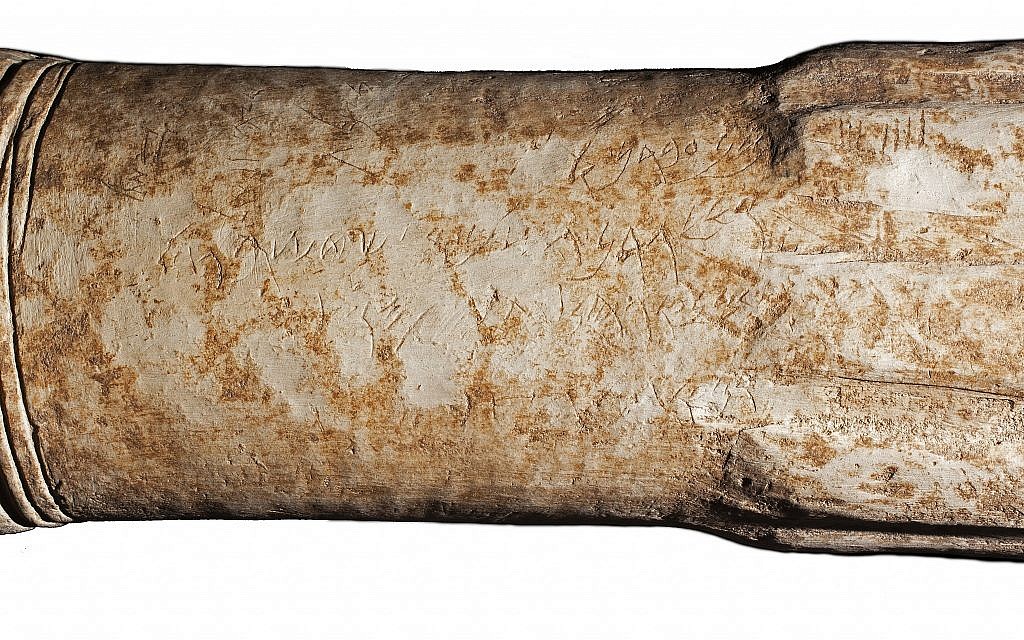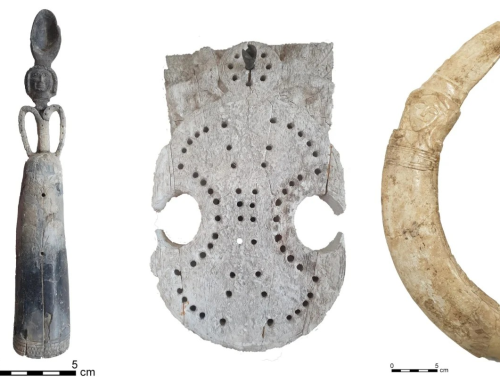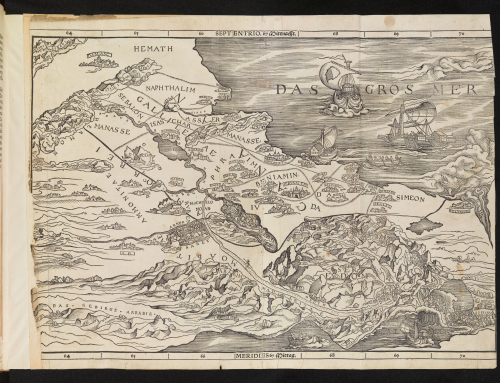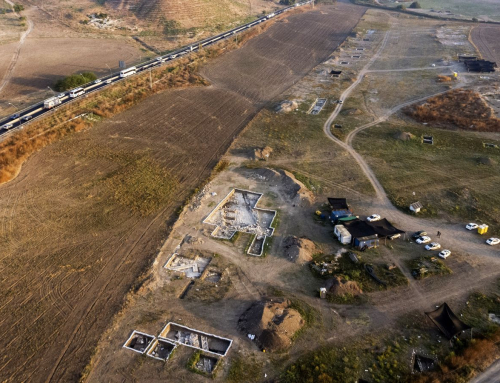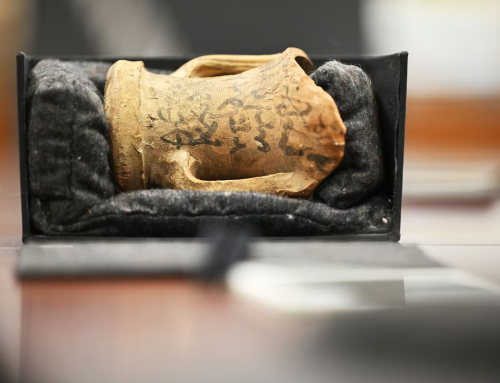The sanctuary, a single 4.8 m x 4.9 m room, was erected at the high point of the town, writes Ji, and was equipped with a platform, an altar, offering tables and a fireplace. The small inscribed altar was found in situ in a layer that Ji, as well as other leading archaeologists, have dated to 9th–8th centuries BCE based on stratification, carbon dating and pottery typology.
In terms of both content and language, the new inscriptions represent a missing link between the Mesha Stele and later Moabite texts such as the Khirbet Mudineyah Incense Altar.
Incense altars of this period are quite common, epigrapher and historian Michael Langlois told The Times of Israel, “but few are inscribed, which makes this find all the more interesting.”
“The scripts of these inscriptions are different from that of the Mesha Stele, and of lesser quality. The altar is not meant to be an impressive victory stele as the Mesha stele, and the scribes are less skilled, but such inscriptions are nonetheless of great value to better understand the culture, history, language and religion of these ancient peoples,” said Langlois, who did not participate in the recent Levant article, but traveled to Jordan to examine the altar upon its excavation in 2010.
Rollston emphasized the inscriptions’ importance to gaining a more holistic picture of the region, saying, “When one combines the biblical material in Kings, the Mesha Stele and the Ataruz Inscriptions, a fairly full picture comes to life, one in which one can stitch together the biblical and inscriptional evidence and know a great deal about geopolitics in the ancient Levantine world of the late 9th and early 8th centuries.”
What is the Mesha Stele and what happened at Atarot?
Today housed in the Louvre, the black basalt Mesha Stele was discovered in 1868 in the rubble of Jordan’s biblical Divon. Through a too-Hollywood-to-believe serious of events, the 1.15-meter-high, 60-68-centimeters-wide tablet was smashed by betrayed Bedouin, but eventually sold piecemeal to the highest bidder. Only some 700 of its approximately 1,000 Moabite script letters are in hand, some of which, although inscribed by a professional hand, is illegible due to damage.
The commemorative stele was commissioned by King Mesha and hails from ancient Moab in the 9th century BCE, explained leading Rollston in an email to The Times of Israel. Written in Hebrew letters but in the Moabite language, the Stele “dovetails remarkably with the biblical material in the Book of Kings, and also provided a great deal of additional information about these laconic verses from the Bible.”
Written from the perspective of a victorious king, the stele depicts an Atarot recaptured from the oppressive Israelite Northern Kingdom that had conquered it as its borders expanded.
“According to Mesha’s own words in the Mesha Stele, Moab rebelled against Israel and gained its independence from Israel,” said Rollston, who is also listed as an author on the Levant article.
As Bean writes in the article, in the stele, “Mesha notes that he fought against the city, took it and killed the entire population before bringing back some sort of looted cultic object for presentation to his god Kemosh in Qiryat. And Mesha also states that he settled in it the Sharonites and the Maharatites.”
The new inscriptions appear to pick up the story after the reconquest of Atarot by Mesha and provide “important new historical evidence for this Moabite occupation of Atarot in the 9th century BCE,” writes Bean.
However, the altar itself is damaged, as are the two inscriptions, making all readings difficult, and somewhat hypothetical.
Using Egyptian Hieratic numeral signs intermixed with alphabetic words, Inscription A “appears to tabulate small quantities of metal, possibly for some purpose relating to the cultic context of the inscription,” writes Bean, a PhD Candidate in Near Eastern Studies at Johns Hopkins University and Visiting Assistant Professor of Biblical Studies at Milligan College in Tennessee.
Bean’s reading of Inscription A is, “For/with 8 shekels of bronze/And this: 2 shekels of bronze/Total plunder: 10.” He wryly remarked in the Levant article that “At the very least, it can be asserted that the scribe was competent in addition.”
“Nonetheless, one of the ideas we consider is that Inscription A, which records quantities of metal (bronze, we propose), records and thereby dedicates offerings. As we emphasize in the article, these are just working hypotheses to be considered,” said Bean.
Who else lived at Atarot: Sea Peoples, Philistines, Israelites?
The new inscriptions as well as other archaeological artifacts could corroborate the biblical and Mesha Stele narratives about previous inhabitants of Atarot prior to Mesha’s conquest and annihilation of all its residents.
According to Rollston, “The Mesha Stele also mentions that the ‘Gadites’ had lived in the land of ‘Atarot (i.e, Ataruz) forever and that the king of Israel had built ‘Atarot (i.e, Ataruz) for himself.” He notes that the tribe of Gad was an Israelite tribe, which had received a tribal allotment in this region, as per the narratives of Joshua 4:12. “Then Mesha notes that he retook the city, killed the Gadite population and made it a Moabite city,” said Rollston.
Archaeologist Ji, also the dean of education at La Sierra University in Riverside, California, said that located in strata prior to that of the inscribed altar at the Ataruz site, there is a non-Moabite Iron IIA temple. He is unsure whether it was settled by the Israelites, such as the Gadites, or even another as yet unnamed people, but said the Mesha Stele could potentially offer clues.
“After the destruction of this temple, a Moabite sanctuary was built at the site, which is dated to the late 9th-early 8th centuries BCE. Hence, Ataruz is a showcase site showing what was Moabite and what was non-Moabite (Israelite?),” said Ji in an email.
What exactly was the nature of the Moabite kingdom is still debated by scholars, said Ji, who argue whether it was a true kingdom or a confederation of tribal groups. He believes that the Moabite kingdom took over territory east of the Jordan River from the northern Israel kingdom and that, comparable to Judah or Israel, King Mesha “stepped up as a de facto king” who brought economic prosperity and political stability.
The Moabite kingdom “might have also been relatively short-lived, and its political system was somewhat fragmentary rather fully centralized. This kind of socio-economic limit might be related to the non-grandiose nature of Moabite architecture and material culture,” Ji told The Times of Israel.
There is also archaeological proof of Sea Peoples and Philistine influences found at the site, said Ji. In the pre-Moabite temple layers, there are indications of Phoenician and Egyptian culture on some objects, he said. “There seem to have been some contacts between Moab and the western region,” he noted, probably through the Jordan Valley.
So were there Hebrews at Atarot?
With cautious support, in the Levant article, Bean reiterates the proposal Rollston made publicly in 2011 that the word “Hebrews” could possibly appear in the much damaged Inscription B.
“In the article we emphasize that this reading is possible, and plausible, but not certain. The uncertainties of the surrounding context in Line B.1 make it very difficult to say much more than that at present. It is obviously a fascinating possibility for the historical use of this term,” Bean told The Times of Israel.
Independent scholar Langlois said that in the case of the Ataruz altar, the basic meaning of the term “Hebrews” “is that of people who pass or cross. Interestingly enough, the same inscription also refers to migrants, using the same Hebrew word ‘ger‘ that is common in the Bible.”
Noting that “nothing is absolute in archaeology and science,” archaeologist Ji added that the reading of “Hebrews” and “ger” as “foreigners” fits well with the archaeological evidence at the site. “The inscription is from the post-destruction period with a Moabite signature. So, the Ataruz inscription is possibly mentioning the non-Moabite predecessors (pre-destruction period) at the site as ‘foreigners,’” wrote Ji in an email.
Only one thing is certain, said Bean: that the meaning or very existence of the term “Hebrews” on the inscription will continue to be debated by scholars.
“The rarity of such inscriptions reminds us of how little we know about the biblical world,” noted researcher Langlois.
“Too often we view this world through the lenses of the biblical writers; for once, we have an opportunity to view this world from another angle — from the perspective of Israel’s neighbors. As always, it’s of paramount importance to listen to both sides in order to have a balanced view of the situation. This is still true today,” said Langlois.

